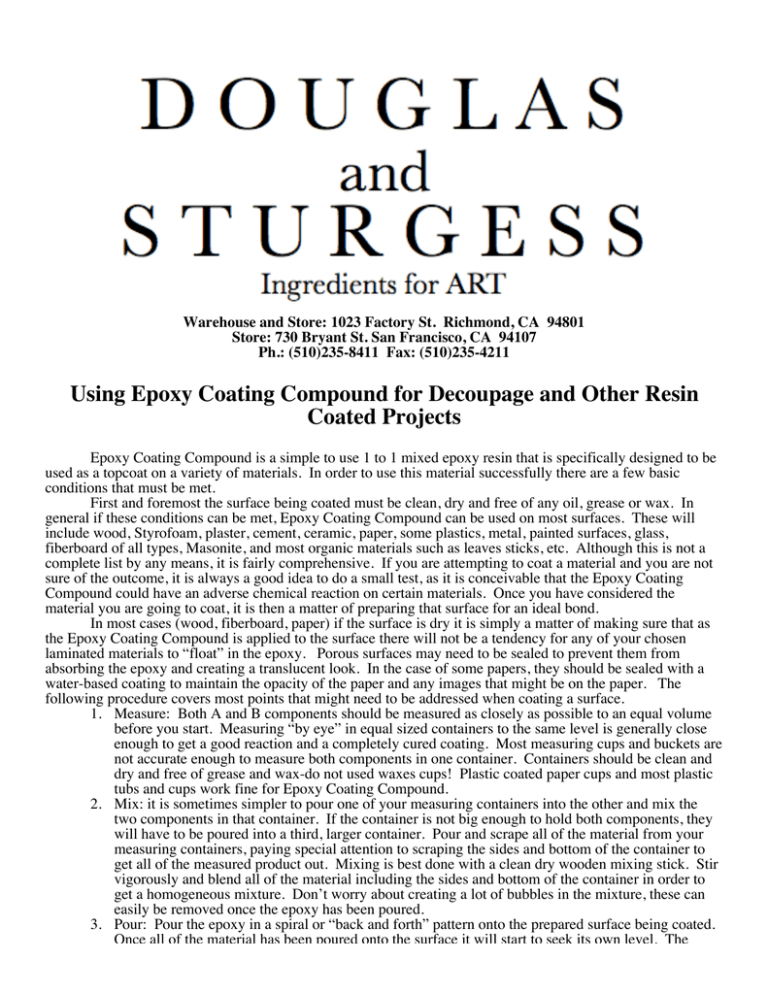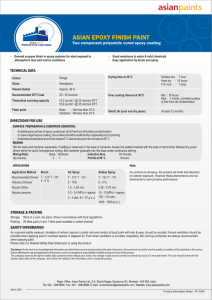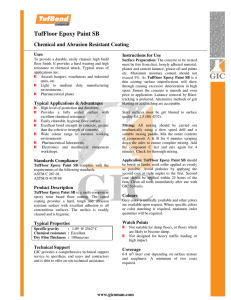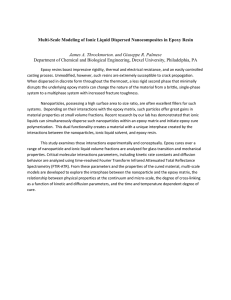Epoxy Coating Compound
advertisement

Warehouse and Store: 1023 Factory St. Richmond, CA 94801 Store: 730 Bryant St. San Francisco, CA 94107 Ph.: (510)235-8411 Fax: (510)235-4211 Using Epoxy Coating Compound for Decoupage and Other Resin Coated Projects Epoxy Coating Compound is a simple to use 1 to 1 mixed epoxy resin that is specifically designed to be used as a topcoat on a variety of materials. In order to use this material successfully there are a few basic conditions that must be met. First and foremost the surface being coated must be clean, dry and free of any oil, grease or wax. In general if these conditions can be met, Epoxy Coating Compound can be used on most surfaces. These will include wood, Styrofoam, plaster, cement, ceramic, paper, some plastics, metal, painted surfaces, glass, fiberboard of all types, Masonite, and most organic materials such as leaves sticks, etc. Although this is not a complete list by any means, it is fairly comprehensive. If you are attempting to coat a material and you are not sure of the outcome, it is always a good idea to do a small test, as it is conceivable that the Epoxy Coating Compound could have an adverse chemical reaction on certain materials. Once you have considered the material you are going to coat, it is then a matter of preparing that surface for an ideal bond. In most cases (wood, fiberboard, paper) if the surface is dry it is simply a matter of making sure that as the Epoxy Coating Compound is applied to the surface there will not be a tendency for any of your chosen laminated materials to “float” in the epoxy. Porous surfaces may need to be sealed to prevent them from absorbing the epoxy and creating a translucent look. In the case of some papers, they should be sealed with a water-based coating to maintain the opacity of the paper and any images that might be on the paper. The following procedure covers most points that might need to be addressed when coating a surface. 1. Measure: Both A and B components should be measured as closely as possible to an equal volume before you start. Measuring “by eye” in equal sized containers to the same level is generally close enough to get a good reaction and a completely cured coating. Most measuring cups and buckets are not accurate enough to measure both components in one container. Containers should be clean and dry and free of grease and wax-do not used waxes cups! Plastic coated paper cups and most plastic tubs and cups work fine for Epoxy Coating Compound. 2. Mix: it is sometimes simpler to pour one of your measuring containers into the other and mix the two components in that container. If the container is not big enough to hold both components, they will have to be poured into a third, larger container. Pour and scrape all of the material from your measuring containers, paying special attention to scraping the sides and bottom of the container to get all of the measured product out. Mixing is best done with a clean dry wooden mixing stick. Stir vigorously and blend all of the material including the sides and bottom of the container in order to get a homogeneous mixture. Don’t worry about creating a lot of bubbles in the mixture, these can easily be removed once the epoxy has been poured. 3. Pour: Pour the epoxy in a spiral or “back and forth” pattern onto the prepared surface being coated. Once all of the material has been poured onto the surface it will start to seek its own level. The 4. 5. 6. 7. spreading of the epoxy should be done with a notched plastic spreader, much like one that might be used to apply adhesive to a floor. These can be acquired at most building supply stores. In the absence of a notched spreader, a plastic squeegee can be notched with a razor blade for the same effect. Use this spreader to move some of the material around the surface until you have a fairly even coating. The epoxy will seek its own level and create a glassy smooth surface as it cures. Bubble Release: Although bubbles in the coating can be removed by gently exhaling onto the surface to apply CO2 to the epoxy, a propane torch does a much more effective job of releasing the entrapped air. To utilize a torch it works best if the torch has a flame spreader attached to it and gently wave the torch over the coated surface holding the flame four to six inches from the surface. It will become immediately obvious that the air bubbles are releasing from the surface and bursting in place leaving a flawless layer of resin. Do this procedure a couple of times until no more visible bubbles are entrapped in the epoxy. Curing: Epoxy Coating Compound was designed to cure at room temperature in approximately 12 hours at room temperature. This is the point at which dust will no longer have a detrimental effect on the surface. It is important however to allow the epoxy to cure for at least 72 hours at room temperature to get a surface that is impervious to marring from touching it with hard or rough objects. Cure can be accelerated with mild heat, up to about 90 degrees F. Other points to ponder: To get an even coating, it is best if the surface being coated is flat and level. A carpenter’s level is a great tool to check the “levelness” of your surface. It is also a good idea to prop the object being coated on some cups or other objects so that the epoxy can drip off the sides of your work onto newspaper placed under the work. Epoxy Coating Compound is sticky stuff and will adhere to most surfaces-even those you might not want it to stick to. For this reason it is a good idea to use lots of newspaper or other drop cloth type materials under your work to avoid damaging your working surface. Drips on the underside of the object being coated can be scraped off when the epoxy is in a semi-gelled state, or they can be cut off when the epoxy is semi-cured. If the epoxy is allowed to cure completely, the drips will have to be either sanded or ground off with an abrasive tool. Coverage: At 1/16” thickness, a gallon of Epoxy Coating Compound will cover approximately 24 square feet. In other words, a half gallon of part A plus a half gallon of part B will cover about 24 square feet to 1/16” depth. Using Epoxy Coating Compound on porous surfaces: Porous surfaces must be sealed for the best result. This can be done by brushing a coat of the epoxy onto the surface before you do a poured coat. This is the best method to use as the epoxy will bond intimately to itself and for a seamless coating. If coating paper laminated to a wooden surface, it is a good idea to coat the paper with a water based coating first to prevent the epoxy from being absorbed into the paper and rendering it transparent. The water based coating must be allowed to dry completely before the epoxy is applied. Table tops: If Epoxy Coating Compound is to be used as a table top coating, it is imperative that the coating be allowed to cure fully before putting the table to use. In addition, once the table has cured and a heavy object is placed on the surface, that surface may show a dent when the object is removed. Generally, this denting will disappear within a couple of days after the object is removed. Cleaning and preserving the finish: The Epoxy Coating Compound surface may be cleaned with most common household cleaners. Do not allow strong solvent like acetone and lacquer thinner to stay on the surface any longer than necessary. These may be used to remove any paint that might spill onto the surface, but again do not allow these solvents to stay there any longer than necessary. A coating of a high quality carnauba wax is an excellent way to preserve the surface quality. Satin finish: If a lower gloss surface is desired one can use rottenstone or even a very fine grade of steel wool or a plastic abrasive pad to achieve a satin finish. It is helpful to use water with these materials to simplify this procedure. Other uses: Epoxy Coating Compound also finds use as a hard shell finish on props and other objects made from paper mache and Styrofoam. It is also possible to color the coating by the addition of dry pigments and dyes to achieve a specific effect. With a little practice it is possible to use this versatile material on a wide variety of surfaces and products. “The information and data contained herein are based on information we believe reliable. Each user of the material should thoroughly test any application and independently conclude satisfactory performance before commercializing. Suggestions of uses should not be taken as inducements to infringe on any particular patent.”



